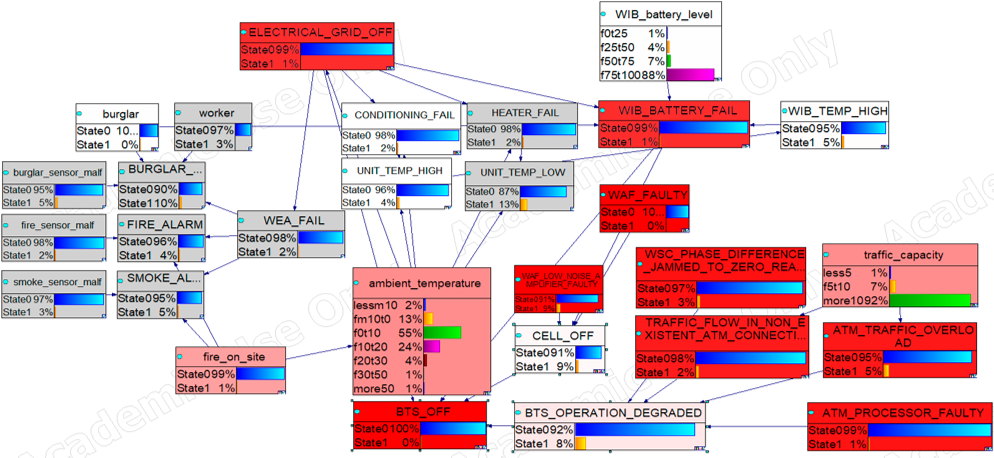
Grigoryev Konstantin Ernstovich
Faculty of Computer Technologies and Applied Mathematics
Department of Information Technologies
Specialty: "Applied Mathematics and Computer Science"
Information Technology for Predicting Emergency Situations in ICT Operation
Scientific Supervisor: Ph.D., Associate Professor Poletaykin A. N.
Personal Information
Full Name: Grigoryev Konstantin Ernstovich
Date of Birth: 12/18/2000
Place of Birth: Krasnodar
Education
School: Gymnasium No. 18
Bachelor's Degree: KubGAU, Specialty: Electrical Power Engineering and Electrical Engineering (2018-2022), GPA 4.66
Master's Degree: KubSU, Specialty: Applied Mathematics and Computer Science (2023-2025), GPA 4.5
Work Experience
 Magnit Tech – L2 Engineer (Logistics) (08.2024 - Present)
Magnit Tech – L2 Engineer (Logistics) (08.2024 - Present)

Languages
Russian (native)
English (advanced)
Contact Information
Email: example@example.com
Phone: +7 800 555 35 35
Skills and Specialization
Technology Stack: Python, Go
Infrastructure: Nginx, Docker, Kubernetes
Databases: PostgreSQL, MySQL, Oracle
Version Control: Git, GitLab, GitHub
Networking Technologies: REST, gRPC, WebSockets
Cloud Solutions: Yandex
CI/CD: GitLab CI
Achievements
Competitions:
- Winner of the "Green Owl" competition with the project "Verification Method for Green Energy Volumes," 2020.
Scientific Publications:
- Oskin, S., Tsokur, D., Voloshin, A., Grigorev, K., & Tsokur, E. (2021). Simulation of Thermal Processes in a Greenhouse. Proceedings of the 20th International Scientific Conference Engineering for Rural Development, Jelgava, Latvia, May 26-28, 2021, 1715-1720.
Hobbies
Interests:
- Games: Crusader Kings III, Hearts of Iron 4, Oxygen Not Included
- Literature: "Les Misérables" by Victor Hugo, "The White Guard" by Mikhail Bulgakov, "Vanity Fair" by William Thackeray, "The Moon and Sixpence" by W. Somerset Maugham
Abstract of the Thesis
Original: priceless
Table of Contents
Introduction
This coursework examines risk management methods related to emergency situations (ES) in cellular base station equipment. Given the constant growth in the number of mobile device users and increased network load, mobile operators need to ensure a high level of service quality and reliability. The work focuses on studying the main types of risks, their potential threats and consequences, as well as developing methods to minimize these risks. Special attention is paid to simulation modeling using BayesFusion GeNIe software to assess the probabilities of various emergencies and their impact on the operation of base stations. The study includes analyzing emergency messages, equipment states, and applying Bayesian networks to refine the probabilities of event occurrences, as well as presenting the results in the form of tables and histograms.
1. Relevance of the Topic
Cellular communication has become an integral part of everyday life, providing users with instant connectivity and data access. As the number of mobile device users increases, the load on networks grows, creating a need for effective risk management related to emergencies (ES) in base station equipment. Hardware failures, software errors, and external impacts can significantly affect network reliability and service quality, making the topic of risk management particularly relevant for cellular operators. Modern risk management methods, including Bayesian networks, enable more accurate forecasting and minimization of the consequences of emergencies, contributing to the stability and resilience of mobile infrastructure.
2. Goals and Objectives of the Research, Planned Results
To study methods and approaches for managing risks associated with emergency situations in cellular base station equipment and to develop a model that allows for effective forecasting and minimization of the consequences of emergencies.
Key objectives of the research:
- Analysis of methods to minimize the number of states in automata.
- Study of the influence of FPGA architecture on system performance.
- Development of methods for automating the synthesis process of automata.
- Implementation of software solutions for simulation modeling.
- Evaluation of the effectiveness of proposed solutions in practice.
Planned results:
- Creation of an effective Bayesian model for forecasting risks of emergencies at base stations.
- Development of practical recommendations for cellular operators on risk management.
- Contribution to the scientific community with new data and approaches to risk management in the field of mobile communications.
3. Overview of Research and Developments
Risk management is a complex and multifaceted process designed to identify, assess, and mitigate risks associated with various organizational activities. Modern approaches to risk management encompass a wide range of methods based on both scientific research and practical experience. These methods are generally divided into qualitative and quantitative approaches. However, the integrative approach presents significant research interest due to its ability to provide a more comprehensive understanding of risks and to develop more effective risk management strategies.
Integrative Risk Management Methods
Among these integrative methods, Failure Modes and Effects Analysis (FMEA) stands out. This method systematically identifies potential failure modes, assesses their possible consequences, and determines measures to reduce these risks. Traditional FMEA has been expanded to include Failure Modes, Effects, and Criticality Analysis (FMECA), which incorporates the assessment of failure criticality. This extension enhances the ability to evaluate the impact and significance of various failure modes. FMECA is widely used in telecommunications systems and has been the subject of extensive research. As an integrative method, FMECA has been combined with optimization modeling and machine learning, demonstrating its versatility and effectiveness.
Another notable integrative method is the Fuzzy Delphi Method (FDM). FDM combines the Delphi method, which gathers expert opinions, with fuzzy logic to handle the inherent uncertainty and imprecision in expert judgments. This method is particularly valuable for assessing risks that are difficult to quantify, such as strategic and operational risks. It has also been applied in telecommunications, similarly to FMECA, to assess the criticality of various emergency situations.
Bayesian networks represent a powerful and widely used tool for risk analysis, facilitating the modeling of probabilistic dependencies between various events. This method has also been applied in conjunction with FMEA for managing failure risks in telecommunications systems. The widespread application of Bayesian networks in IT project risk analysis has been explored, where project management methods and simulation modeling were integrated. The use of Bayesian networks for risk analysis has shown high effectiveness across a wide range of factors. Furthermore, research on risk analysis in medical evacuation has been published by the same researcher.
Interpretive Structural Modeling (ISM) is another integrative method that helps to understand complex relationships between various elements of the analyzed process and to structure these relationships to support decision-making. In the telecommunications field, ISM is used to analyze hierarchical dependencies among risk factors. ISM can be used both independently and in combination with other methods, such as FDM, for risk assessment in telecommunications systems.
Comparison of Methods
Each of these integrative methods has unique advantages and specific application areas in risk analysis and management. FMECA is a traditional method that systematically identifies potential failure modes and assesses their consequences. However, it often faces challenges related to uncertainty and the complexity of interactions between risks. FDM improves the process by incorporating fuzzy logic, allowing for more effective handling of uncertainties in expert judgments. Nevertheless, it still requires significant effort to gather and reconcile expert opinions. ISM supports the structuring of complex hierarchical relationships among risk factors but may have limitations in quantitatively assessing probabilities and consequences.
Bayesian networks, on the other hand, offer significant advantages due to their ability to predict a wide range of risk events and model probabilistic dependencies between these events. They not only aid in identifying and assessing risks but also provide insights into the relationships between risks. This capability is particularly valuable in complex systems, such as telecommunications, as it allows for more accurate forecasting of the consequences of various scenarios and supports informed decision-making for risk mitigation. Bayesian networks also provide clear explanations of their conclusions, allow logical interpretation, and modification of relationships between variables in analysis, while explicitly accounting for prior expert experience. The methodological applications of Bayesian networks include:
- prediction or direct inference (determining the probability of an event based on observed causes);
- diagnosis or backward inference (determining the probability of a cause based on observed consequences);
- causal (mixed) inference (determining the probability of one of the causes of an event considering the occurrence of one or more other causes of that event).
4. Application of Bayesian Networks for Risk Management in Cellular Base Stations
To create the model, the basis was formed from the failure reports of the Nokia WCDMA base station, generated by the failure output block. These reports respond to the influence of various factors. A total of 120 failures were identified, registered by WCDMA Nokia MetroSite base stations. A simplified model is considered, based on the 26 most frequently encountered reports, as well as data collected by the base station monitoring system (ambient temperature, bandwidth, battery charge). Together, this data provides insights into the current state and operational capability of the base station.
By definition, a Bayesian network is a set of variables (nodes) and their probabilistic dependencies (connections). The connections between the nodes in this Bayesian network model are causal, and their probabilities were calculated using the frequency method based on data collected from real base stations during the experiment. The BayesFusion GeNIe software package was used to create the Bayesian network [14]. The final network is shown in Fig. 1.

Fig. 1. The created Bayesian network in BayesFusion GeNIe
The created Bayesian network allows for the assessment of equipment failure risks at the base station based on input data. The model analyzes the current state of the equipment and calculates the probabilities of various failures. This enables operators to take necessary actions in advance, reducing the risk of downtime and increasing network reliability. The following parameters for the base station are introduced into the model:
- temperature in the cabinet: 28.8 °C
- WIB charge: 72%
- bandwidth: 3.6%
The emergency reports received from the base station include: BURGLAR_ON, SMOKE_ALARM, FIRE_ALARM, WIB_TEMP_HIGH. As a result, the model calculates the probabilities of risk events. Table III shows the risk events with a probability greater than 0.01.
Table 1. Simulation Results in the BayesFusion GENIE Environment
| Fault | Probability |
|---|---|
| WEA_FAIL | 0.985 |
| UNIT_TEMP_HIGH | 0.664 |
| BTS_OPERATION_DEGRADED | 0.433 |
| ATM_TRAFFIC_OVERLOAD | 0.340 |
| TRAFFIC_FLOW_IN_NON_EXISTENT_ATM | 0.133 |
| CONDITIONING_FAIL | 0.079 |
| burglar_sensor_malf | 0.077 |
| worker | 0.057 |
| fire_sensor_malf | 0.054 |
| smoke_sensor_malf | 0.054 |
| HEATER_FAIL | 0.049 |
| ELECTRICAL_GRID_OFF | 0.045 |
| WIB_BATTERY_FAIL | 0.037 |
| CELL_OFF | 0.030 |
| BTS_OFF | 0.028 |
| fire_on_site | 0.016 |
| burglar | 0.012 |
Conclusions
The main advantage of Bayesian networks over other directed structures in risk analysis lies in their ability to correlate prior and posterior probabilities of critical events that determine the fatal development of a situation under specific risk conditions. This allows for the quantitative tracking of new information about the risk object alongside already available preliminary data. Such comparisons facilitate productive management interventions. Thus, the Bayesian management principle is implemented not only in overall management but also in current risk management at the level of business process owners in telecommunications. Analyzing this principle in operations of directed networks enhances the overall adequacy of the model representation of interrelated risk events.
The application of Bayesian networks for calculating the risks of emergency situations in base station equipment has proven effective. The developed model not only calculates the probability of emergencies in base station equipment but also identifies critical points within the described system. Based on the simulation results, recommendations have been formulated to minimize the risks of emergency situations, aimed at increasing the resilience and reliability of base stations and improving the overall quality of services provided.
Список источников
[1] I.A. Buntsev, V.S. Kanev, “System management of risks in telecommunications (the state of the problem, methods, models, realizations) [Sistemnoe upravlenie riskami v telekommunikaciyah (sostoyanie problemy, metody, modeli, realizacii)]” (in Russian), The Herald of the Siberian State University of Telecommunications and Information Science. 2009;(1):26-52.
[2] H. Zhang , Z.R. Wang, X.W. Wang, F.C. Lin, “Practice and Research on FMEA of Telecommunication Satellite System”, Signal and Information Processing, Networking and Computers. Lecture Notes in Electrical Engineering, 2023, vol 917, Springer, Singapore, https://doi.org/10.1007/978-981-19-3387-5_110.
[3] M. R. Alijanzadeh, S. A. Shayannia and M. M. Movahedi, “Optimization of maintenance in supply chain process and risk-based critical failure situations (case study: Iranian oil pipeline and telecommunication company, north district)”, Journal of applied research on industrial engineering , 2024, 11(1), 125-142.
[4] M.J. Carretero-Ayuso, G. Sánchez-Barros, J. González-Domínguez, J. García-Sanz-Calcedo, “Failure Modes in Electricity and Telecommunication Facilities in Dwellings in Spain”, Appl. Sci. 2021, 11, 5274, DOI: 10.3390/app11115274.
[5] B.L. Tarcsay, Á. Bárkányi, S. Németh, T. Chován, L. Lovas , A. Egedy, “Risk-Based Fault Detection Using Bayesian Networks Based on Failure Mode and Effect Analysis”, Sensors, 2024, 24(11):3511.
[6] V. Nalluri and L. Chen, “Risk assessment for sustainability on telecom supply chain: A hybrid fuzzy approach.”, Uncertain Supply Chain Management, 2022, 10(2), 559-576.
[7] V.V. Tsyganov and I.V. Gurlev, “Cognitive forecasting of information and telecommunication infrastructure of a large-scale region [Kognitivnoe prognozirovanie informacionno-telekommunikacionnoj infrastruktury krupnomasshtabnogo regiona]” (in Russian), ITNOU: information technologies in science, education and management [ITNOU: informacionnye tekhnologii v nauke, obrazovanii i upravlenii], 2020, No. 1 (15).
[8] A. Mishra, D. Kumar, M. Shuaib, M. Tyagi, R. Singh. Measurement of Critical Factors: A Case of Telecommunication Industry, Operations Management and Systems Engineering, 2021, pp.259-274, doi: 10.1007/978-981-15-6017-0_16.
[9] B. Bayas and C. Zambrano, “Bayesian networks applied to error prediction in software-defined networks [Redes bayesianas aplicadas a la prediccion de errores en las redes definidas por software]” (in Spanish) , 2021, 13. 419-429.
[10] K. O. Dumbrays and O. M. Glushchenko, “Modeling and risk analysis of IT projects [Modelirovanie i analiz riskov IT-proektov]” (in Russian), Science and education today [Nauka i obrazovanie segodnya], 2021, No. 2 (61). pp. 26–33.
[11] Y. Shevtsova, D. Demchuk, A. Poletaikin, K. Demchuk, “Application of artificial intelligence methods in estimation the risk of transporting a patient by road”, 2023, E3S Web of Conf. Volume 402, 2023 International Scientific Siberian Transport Forum - TransSiberia 2023. DOI: 10.1051/e3sconf/202340203009.
[12] D. Adib, H. Safarzadeh and M. Mohammadi. “Designing and explaining the IoT commercialization model in Iranian organizations (Telecommunication Company of Iran): An interpretive structural modeling (ISM) approach”, International Journal f Nonlinear Analysis and Applications, 2023, 14(1), pp. 723-738, doi: 10.22075/ijnaa.2022.26942.3456.
[13] W.-K. Chen, V. Nalluri, S. Ma, M.-M. Lin, C.-T. Lin, “An Exploration of the Critical Risk Factors in Sustainable Telecom Services: An Analysis of Indian Telecom Industries”, Sustainability 2021, 13, 445. DOI: 10.3390/su13020445.
[14] BayesFusion LLC, GeNIe Modeler: User's Manual, [Online], 2024, Available: https://support.bayesfusion.com/docs/GeNIe.pdf.
[15] L.C. Gaag and U. Kjaerulff, “Making Sensitivity Analysis Computationally Efficient”, Proceedings of the 16th Conference on Uncertainty in Artificial Intelligence, 2000, pp. 317 – 325.